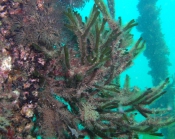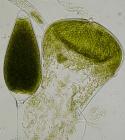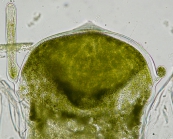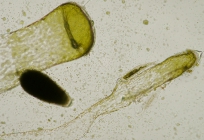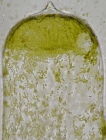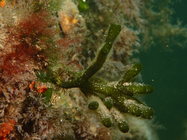
| Introduction | | Search taxa | | Taxon tree | | Taxon match | | Checklist | | Literature | | Stats | | Photogallery | | OBIS Vocab | | Log in |
CaRMS taxon detailsCodium fragile subsp. fragile (Suringar) Hariot, 1889
370562 (urn:lsid:marinespecies.org:taxname:370562)
accepted
Subspecies
marine
(of ) Suringar, W.F.R. (1867). Algarum Japonicarum Musei Botanici L.B. Index praecursorius. Annales Musei Botanici Lugduno-Batavi, 3: 256-259, available online at https://www.biodiversitylibrary.org/page/680893
page(s): 258 [details]
LSID urn:lsid:algaebase.org:taxname:90187
LSID urn:lsid:algaebase.org:taxname:90187 [details]
Guiry, M.D. & Guiry, G.M. (2021). AlgaeBase. World-wide electronic publication, National University of Ireland, Galway (taxonomic information republished from AlgaeBase with permission of M.D. Guiry). Codium fragile subsp. fragile (Suringar) Hariot, 1889. Accessed through: Kennedy, M.K., L. Van Guelpen, G. Pohle, L. Bajona (Eds.) (2021) Canadian Register of Marine Species at: http://marinespecies.org/carms/aphia.php?p=taxdetails&id=370562 on 2024-04-19
Nozères, C., Kennedy, M.K. (Eds.) (2024). Canadian Register of Marine Species. Codium fragile subsp. fragile (Suringar) Hariot, 1889. Accessed at: https://www.marinespecies.org/carms/aphia.php?p=taxdetails&id=370562 on 2024-04-19
Date action by
original description
(of ) Suringar, W.F.R. (1867). Algarum Japonicarum Musei Botanici L.B. Index praecursorius. Annales Musei Botanici Lugduno-Batavi, 3: 256-259, available online at https://www.biodiversitylibrary.org/page/680893
page(s): 258 [details] context source (Introduced species) Katsanevakis, S.; Bogucarskis, K.; Gatto, F.; Vandekerkhove, J.; Deriu, I.; Cardoso A.S. (2012). Building the European Alien Species Information Network (EASIN): a novel approach for the exploration of distributed alien species data. <em>BioInvasions Records.</em> 1: 235-245., available online at http://easin.jrc.ec.europa.eu [details] Available for editors basis of record Guiry, M.D. & Guiry, G.M. (2023). AlgaeBase. <em>World-wide electronic publication, National University of Ireland, Galway.</em> searched on YYYY-MM-DD., available online at http://www.algaebase.org [details] additional source Occhipinti-Ambrogi, A., A. Marchini, G. Cantone, A. Castelli, C. Chimenz, M. Cormaci, C. Froglia, G. Furnari, M.C. Gambi, G. Giaccone, A. Giangrande, C. Gravil, F. Mastrototaro, C. Mazziotti, L. Orsi-Relini & S. Piraino. (2010). Alien species along the Italian coasts: an overview. <em>Biological Invasions.</em> 13(1): 215-237., available online at https://doi.org/10.1007/s10530-010-9803-y [details] Available for editors additional source Marchini, A., J. Ferrario, A. Sfriso & A. Occhipinti-Ambrogi. (2015). Current status and trends of biological invasions in the Lagoon of Venice, a hotspot of marine NIS introductions in the Mediterranean Sea. <em>Biological Invasions.</em> 17:2943–2962., available online at https://doi.org/10.1007/s10530-015-0922-3 [details] Available for editors additional source Verlaque, M.; Ruitton, S.; Mineur, F.; Boudouresque, C.-F. (2007). CIESM Atlas of Exotic Macrophytes in the Mediterranean Sea. <em>Rapport de la Commission de l'Exploration de la mer Méditerranée, Monaco.</em> 38., available online at http://www.ciesm.org/atlas/appendix4.html#top [details] Available for editors new combination reference Hariot, P. (1889). Algues. <em>Mission Scientifique du Cap Horn. 1882-1883. Tome V. Botanique. Cryptogamie.</em> 5: 3-109. page(s): 32 [details]  Present Present  Inaccurate Inaccurate  Introduced: alien Introduced: alien  Containing type locality Containing type locality
From editor or global species database
LSID urn:lsid:algaebase.org:taxname:90187 [details]From regional or thematic species database
Introduced species abundance in Slovenian part of the Adriatic Sea (Marine Region) : Locally common [details]Introduced species abundance in United Kingdom part of the Celtic Sea (Marine Region) : Common [details] Introduced species abundance in United Kingdom part of the English Channel (Marine Region) : Common [details] Introduced species abundance in United Kingdom part of the North Sea (Marine Region) : Common [details] Introduced species abundance in Greece (Nation) : Locally common [details] Introduced species impact in Slovenian part of the Adriatic Sea (Marine Region) : Other impact - undefined or uncertain [details] Introduced species impact in United Kingdom part of the Celtic Sea (Marine Region) : Outcompetes native species for resources and/or space [details] Introduced species impact in United Kingdom part of the English Channel (Marine Region) : Outcompetes native species for resources and/or space [details] Introduced species impact in United Kingdom part of the North Sea (Marine Region) : Outcompetes native species for resources and/or space [details] Introduced species remark in Greece (Nation) : Additional record of this species in marine waters around Greece. C. fragile has restricted distribution in Greece at specific sites but usually at high abundance, often in ports and polluted environments. [details] Introduced species vector dispersal in Belgian part of the North Sea: Ships: general [details] Introduced species vector dispersal United States part of the North Pacific Ocean (Marine Region) Aquaculture: accidental [details] Introduced species vector dispersal in Dutch part of the North Sea : Fisheries: accidental with deliberate translocations of fish or shellfish [details] Introduced species vector dispersal in Dutch part of the North Sea : Shipping [details] Introduced species vector dispersal in Slovenian part of the Adriatic Sea (Marine Region) : Ships: accidental with ballast water, sea water systems, live wells or other deck basins Unintentional introduction attached to shellfish such as oysters, ships hulls or as spores in ballast tanks [details] Introduced species vector dispersal in Belgian part of the North Sea: Aquaculture: accidental [details] From other sources
Alien species The natural area of distribution of Codium fragile fragile is the Pacific region,near Japan. This green algae typically occurs in sheltered areas like harbours, bays, and tidal pools. The species reached Europe by attaching itself on ship hulls, and through transport with shellfish. It was first observed in Belgium in 1939 in the Ostend Sluice dock. It competes with indigenous algae, and frequently forms dense packages on existing shellfish banks. After a decline in in 2003, its abundance in the Ostend Sluice dock increased again since 2006 . [details]
European Network on Invasive Alien Species (NOBANIS) - Codium fragile
Marine Life Information Network - UK Published in AlgaeBase  Published in AlgaeBase  (from synonym Codium fragile subsp. tomentosoides (van Goor) P.C.Silva, 1955) (from synonym Codium fragile subsp. tomentosoides (van Goor) P.C.Silva, 1955)To Biodiversity Heritage Library (1 publication) (from synonym Codium fragile subsp. tomentosoides (van Goor) P.C.Silva, 1955) To Biodiversity Heritage Library (1 publication) To European Nucleotide Archive (ENA) (from synonym Codium fragile subsp. tomentosoides (van Goor) P.C.Silva, 1955) To European Nucleotide Archive (ENA) To GenBank (141 nucleotides; 28 proteins) To GenBank (7 nucleotides; 7 proteins) (from synonym Codium fragile subsp. tomentosoides (van Goor) P.C.Silva, 1955) To Global Invasive Species Database (GISD) (from synonym Codium fragile subsp. tomentosoides (van Goor) P.C.Silva, 1955) To Niet-inheemse soorten Belgisch deel Noordzee en aanpalende estuaria (in Dutch) To PESI To PESI (from synonym Codium fragile subsp. tomentosoides (van Goor) P.C.Silva, 1955) |
